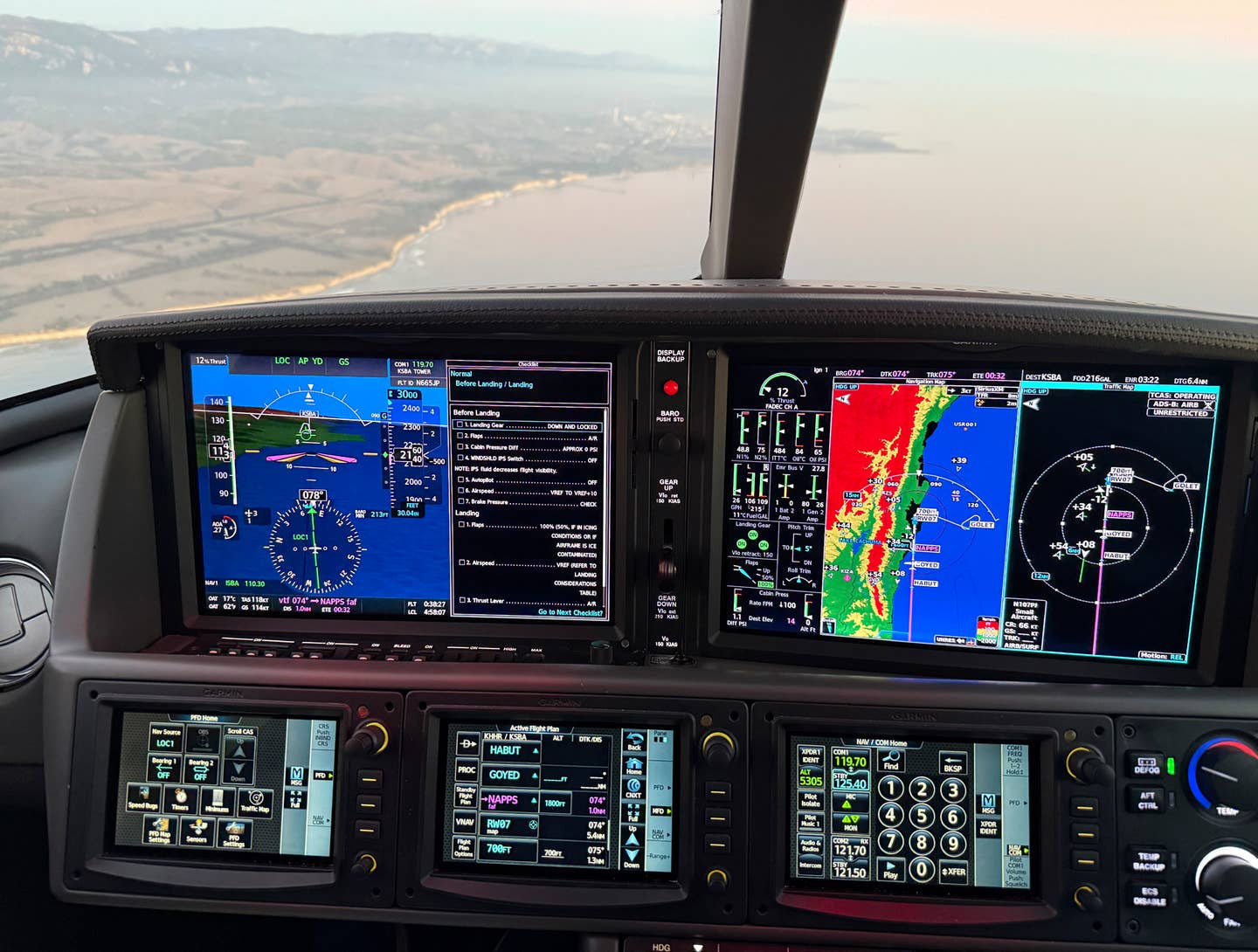
Illustration by Luis Ruiz Padrón
It's a beautiful day and you're enjoying the view from your cockpit. There is not a burble of turbulence in the air and you have a 15-knot tailwind pushing you along. So far it's a perfect flight. But suddenly you smell smoke in the cockpit. You look around trying to determine where the smell is coming from. Is it the engine? Is it electrical? What is going on?
You decide to find a place to land as soon as possible. But do you announce that you're experiencing an emergency? Visions of piles of paperwork flash through your mind … and you worry about getting in trouble with the FAA.
There are a lot of misconceptions about such situations that prevent pilots from declaring an emergency. But by declaring, you will summon additional help that could mean the difference between life and death.
The Federal Aviation Administration defines an emergency as "a distress or an urgency situation." This could constitute a long list of conditions such as an engine failure, engine roughness, other systems failures, an inflight collision or a medical condition of someone on board the airplane. When it comes to making the decision to declare an emergency or not, it should be quite easy. If you feel that a situation is an emergency, it likely is, and you should make that known to ATC.
According to the FAA's Code of Federal Regulations Section 91.3 (b), "In an in-flight emergency requiring immediate action, the pilot in command may deviate from any rule of this part to the extent required to meet that emergency." Part 135 and 121 components of the FARs have similar language to allow the pilot in command to do whatever it takes to address the emergency at hand.
"The rules do not require you to declare an emergency; the protections of that rule apply when addressing an emergency," said Brandt Madsen, a partner and co-chair of the Aerospace Practice Group of the SmithAmundsen law firm in Chicago. "However, declaring the emergency makes it far better from a defense standpoint."
Madsen defended a case for a pilot who deviated from an assigned altitude due to extreme turbulence while flying a Cessna 150. The pilot had dropped his handheld mic, so he couldn't initially communicate his situation. He stabilized the airplane and was about 600 feet off his altitude when ATC called him. At that point he was able to find the mic and he told the controller what had happened. "It's unrealistic in some situations to communicate your emergency before you secure the aircraft," Madsen said. "You want to control the aircraft first." Madsen said the case was ultimately dismissed, but he felt it would have been much easier to defend had the pilot declared his emergency.
The cases in which the regulations of FAR 91.3 may not provide relief in an emergency, Madsen said, are self-caused emergencies such as the results of inadequate preflight, insufficient fuel or failure to get a weather briefing. "But think safety first and let those of us who do litigation worry about that afterward," Madsen said. "A classic case is somebody who has low fuel but is not yet at the fuel starvation point and is concerned whether or not to pull the trigger to declare an emergency. If they do declare an emergency, that then gives them expedited handling by ATC, which avoids a potentially far worse result."
"Aviate, then navigate, then communicate. Litigate shouldn't be on your mind at all," Madsen said. "Safety is paramount here and that's what should rule the day."
Take Your Time
While each emergency can be vastly different, the best thing you can do, if at all possible, is keep a calm, cool mind-set. Doing too much too soon will likely result in a bad outcome. Your situation may be such that you have to make decisions swiftly. But, if possible, think the situation through, get some extra altitude, and see if you can fix the problem at hand. If you can't, see if you can get assistance through ATC. The controller may be able to contact someone on the ground with special knowledge about your situation who can give suggestions on how best to handle it.
When something goes very wrong, experience is invaluable. One of the most extreme survivable emergencies happened to Sean Tucker, the airshow pilot who flies a highly modified Pitts Special named the Oracle Challenger. While Tucker was practicing his aerobatic sequence in 2006, a rod end that was attached to the torque tube for the elevator that controlled the small orange biplane shattered.
The catastrophic failure happened while Tucker was only 10 feet off the ground. Fortunately the airplane snapped away from the ground rather than toward it, but Tucker experienced a 7.5 G pull at 225 mph. "Immediately I thought I was a goner," Tucker said.
The airplane pitched up to about 500 feet and then started pitching down again. Tucker was able to control it slightly by pulling back on the trim lever and by adding and reducing engine power, but the airplane kept oscillating like a yo-yo. "I was trying to get a balance," Tucker said. "Well, after about a minute I got it up to 1,000 feet and that's when I knew I could save my life."
With about 15 minutes' worth of gas, Tucker was trying to determine whether to land the airplane or bail out. But after trying to fly it to an airport the oscillations restarted. Tucker realized that he couldn't control the airplane enough to be sure that he could avoid a very damaging crash. So he chose to jump.
Tucker had climbed up to 9,500 feet to give himself more options. But he ultimately dropped down to 5,000 feet to get a better idea of where the airplane would crash and to ensure that it wouldn't hit someone on the ground.
And this is something you should also consider in the case of a catastrophic emergency. While you want to do all that you can to save your own life, think about the safety of the people on the ground when making decisions about how best to handle your situation.
Be Prepared
The best chance of having a happy ending to an emergency situation is by knowing your airplane and your equipment inside and out. When Tucker experienced his catastrophic rod-end failure, he knew exactly what had happened. He knew the limitations of the airplane and was able to take swift action to keep the airplane away from the ground. While luck allowed Tucker to survive the initial phase of the emergency, his intimate knowledge of the biplane made the difference.
If you fly aerobatics, you are required to wear a parachute. But don't just wear a parachute. Know how to use it. Take some sky-diving lessons so that you know exactly what will happen if you have to jump. "At 1,000 feet you don't have time to second-guess," Tucker said. "You have to immediately make the decision and not fool around. If you doubt yourself, you're going to die."
You should also prepare for the unexpected by practicing emergency procedures regularly. Practicing engine failure procedures, manual landing-gear operations or lost comm procedures, for example, will allow you to remain calm when a true emergency happens.
Knowing your airplane intimately, knowing what to expect and being practiced at handling unexpected situations will help you keep calm when the otherwise stressful situation of an emergency arises. "Luck comes to the one best prepared," Tucker said.
What Do You Say?
In the case of any emergency, the most important thing, as in any phase of flight, is to control the airplane. But once you have the airplane under control and know where you are going, you should communicate your situation to air traffic control.
To alert the controllers that you are having an emergency you should use the word mayday three times to make sure that the message is heard. Use the word pan three times if you are not experiencing an emergency but are in an urgent situation — perhaps you are experiencing a noncritical system failure and want to get on the ground quickly or your engine is running rough but you still have enough power to safely continue to the nearest airport. However, when in doubt, say mayday.
Some FAA field offices take the wording very seriously. Such was the case with the Cessna 150 pilot who deviated from his altitude. "They questioned why he didn't state an emergency and call out mayday, and they took great issue with the fact that he didn't use the accepted terms," Madsen said.
In Tucker's extreme emergency situation, he was communicating with a team on the ground, and, with the help of his team, he took his time to decide first whether the airplane was salvageable and second the best place to exit the airplane without putting people on the ground at risk.
While it is unlikely that you will have a team on the ground that you are intimately familiar with, declaring your emergency will provide you with potentially valuable services. ATC will assist you in whatever way it can in determining the best place to land. It can also alert authorities on the ground to clear a path, if necessary, for you to put the airplane down without placing lives on the ground at risk. Depending on what the issue is with the airplane, ATC may also be able to connect you with someone who is familiar with the issue and can help you. For example, if you have a landing gear extension failure, there may be some steps you can take that are not listed in the POH.
Madsen said that, in some cases, ATC could declare an emergency in your stead to provide you with additional help. A request for the number of souls on board and amount of fuel is an indication that ATC is declaring an emergency on your behalf.
What Happens on the Ground?
Contrary to what many pilots believe, the aftermath of an emergency situation is in most cases no big deal, and certainly not severe enough that it should prevent you from declaring an emergency and getting any help that could be available. In many cases, the only thing that happens is that you have a discussion with an FAA representative about the event.
"If you give a mayday call and yet every command you enter after that point is in compliance with the FARs, there may not be a necessity to report," Madsen said.
If the situation results in a deviation from the regulations, you will likely be required to speak with a controller or local FSDO representative. While some cases end with that discussion, Madsen recommends that you request to make a written report to give yourself some extra time to gather your thoughts. In other cases an occurrence report may be required. But the occurrence report is often just a short statement of what happened.
"Many times it ends with a quick statement of ‘I had an emergency,'" Madsen said.
Tucker once had an incident in which he suddenly smelled smoke while flying a North American T-6 out of Van Nuys, California. He returned to Van Nuys Airport, from which he had departed, called for a precautionary landing and asked for the fire trucks. He informed the controllers that he was going to stay high to give himself more options. The tower controllers asked him to contact approach, but Tucker told them he would stay with them.
"I deviated from their instructions because I was getting closer to the airport and I was thinking maybe the engine was going to blow up," Tucker said. "So I kept hot just so I could have some glide and at least make it to the airport."
What had happened was that a relay switch had shorted out and burned up. "The FAA was very gracious," Tucker said. "The inspector called me up; he asked me to write an occurrence report; he inspected the part and he closed the file. To me that's not a big hassle at all."
If you are asked to file a written report, Madsen recommends that you contact an aviation attorney to help you prepare that document. If an enforcement action ensues from the deviation, the FAA is required to issue a notice of proposed certificate action within six months from the date the incident occurred. The six months is a "pretty hard statute of limitations for the FAA, and after that time period, it cannot pursue you for a suspension or administrative actions," Madsen said.
You can also provide yourself with additional immunity through the Aviation Safety Reporting System (see sidebar). "Under any situations we've discussed you absolutely should submit a NASA form," Madsen said.
While emergency cases generally provide immunity, cases of intentional acts that result in emergencies don't, and the FAA has clearly stated penalties for such offenses. But, what constitutes an intentional act varies from place to place. "It depends in large part on the assistant regional council you're in front of, and different attorneys respond differently," Madsen said.
While it is best to do all you can to avoid emergency situations by staying current, conducting a thorough preflight inspection, checking the weather and knowing your airplane, you cannot prepare for every possible scenario. Ultimately what will give you the best chance of survival is preparedness. The more you practice emergency procedures, the more relaxed you will be once the real thing happens. And the ability to keep calm will help you achieve a successful outcome.
The FAA has provided several layers of protection for pilots who encounter emergency situations. Take advantage of the help you can receive by declaring your emergency. The extra services that you receive could make the difference between life and death. If the airplane is not acting the way it should, don't hesitate to make the call!
The Aviation Safety Reporting System
Any time you feel that you may have been in breach of the FAA regulations, whether the offense resulted in an emergency situation or not, your first reaction may be to try to keep the incident as quiet as possible. But that is not your best course of action. Your best defense is to confess to your deviation and file a report through the Aviation Safety Reporting System (ASRS). Filing such a report provides immunity from civil penalties and certificate action in most cases.
ASRS was put in place to lessen the likelihood of aviation accidents and make the national airspace system safer. Reporting is available for most aviation professionals who are involved with the NAS in some way, such as pilots, air traffic controllers, maintenance technicians and cabin crew. Through the reports, the FAA can learn about incidents in the skies that may help identify deficiencies and discrepancies within the system or could help the agency develop new, improved policies.
While the report doesn't get you out of situations in which you have intentionally broken the rules, the FAA would have to find out about your deviation through other means. NASA acts as an impartial processor of the ASRS to ensure the confidentiality of the person making the report. The confidentiality component was put in place to increase the likelihood of people filing the reports.
It is important to note that in order for you to receive immunity from a deviation, you must file an aviation safety report within 10 days of the incident. Electronic report submissions are available at asrs.arc.nasa.gov. The report can also be submitted by mail. Regardless of how you submit your report, make sure that you keep a record.
Get online content like this delivered straight to your inbox by signing up for our free enewsletter.
We welcome your comments on flyingmag.com. In order to maintain a respectful environment, we ask that all comments be on-topic, respectful and spam-free. All comments made here are public and may be republished by Flying.

Sign-up for newsletters & special offers!
Get the latest FLYING stories & special offers delivered directly to your inbox






